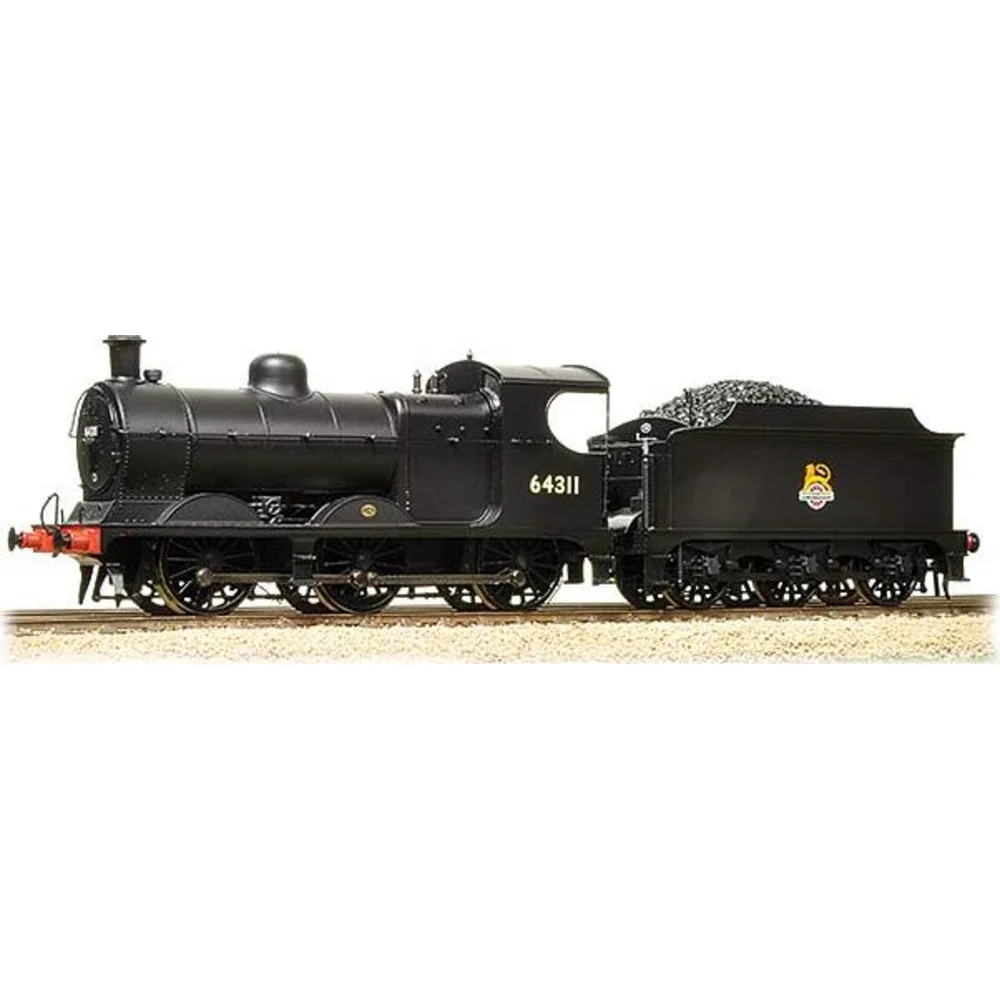Bachmann 31-319
London & North Eastern Railway J11 64311 British Railways Black with Early Emblem
Tooling
Announced in 2013, Bachmann Branchline introduced an all-new OO gauge tooling for the Robinson-designed Great Central Railway Class 9J, later classified by the LNER as Class J11. These 0-6-0 freight locomotives, nicknamed “Pom-Poms,” were built between 1901 and 1910 and served extensively under the GCR, LNER, and British Railways until the early 1960s. The model filled a significant gap for pre-grouping and early LNER enthusiasts, offering a highly detailed representation of this iconic goods engine.
Tooling Features
- Scale: OO gauge (1:76).
- Construction: Precision-moulded plastic bodyshell with mixed metal/plastic chassis for strength and weight.
- Detailing: Factory-fitted separate details including handrails, lamp irons, pipework, reverser, safety valves, smokebox door dart, whistle, sprung buffers, and detailed cab interior with glazing. A fallplate between loco and tender is included.
- Tender: Permanently coupled to the locomotive, housing the PCB and provision for a speaker.
- Couplings: NEM pockets with tension-lock couplers.
Mechanical & Electrical
- Motor: Smooth-running 3-pole motor located in the locomotive.
- Drive: Loco-driven wheels with pickups on 5 of 6 axles.
- Minimum Radius: Second radius curves (approx. 438mm).
- Weighting: Metal components within boiler and chassis for improved adhesion.
- Lighting: No factory lighting fitted.
- Power Collection: 2-rail DC.
DCC Capability
- DCC Ready with a 21-pin socket located in the tender.
- Provision for a speaker for sound installation.
- Factory-fitted DCC and sound versions were also offered in later releases.
Liveries Produced
- Great Central Railway black (Collectors Club limited edition).
- LNER black (1923–1947).
- BR plain black (1948 onwards).
- BR black with early emblem.
- BR black with late crest.
Reviews & Commentary
Model railway reviewers and enthusiasts praised the J11 tooling for its fine detailing, accurate proportions, and smooth running. Video reviews highlight the model’s robust mechanism and authentic appearance, though some noted the permanently coupled tender and absence of factory lighting as minor drawbacks. Social media discussions generally regard the J11 as one of Bachmann’s best pre-grouping releases, with positive feedback on its versatility for freight and mixed-traffic layouts.
Interesting Notes
- The prototype locomotives were known as “Pom-Poms” due to their exhaust sound resembling a quick-firing gun.
- Special editions included weathered and sound-fitted versions for collectors.
Class & Prototype
- Class: London & North Eastern Railway J11
- Traction: Steam
- Built: 1901-1910
- Total Built: 174
- Running Number: 64311
The GCR Class 9J was John G. Robinson's first complete goods locomotive design, with 174 examples built 1901-1910 by five manufacturers. These versatile 0-6-0s hauled coal traffic, mixed goods, and passenger services across six decades, pioneering the Robinson superheater that became LNER Group Standard. Nicknamed "Pom-Poms" for their distinctive exhaust beat, they served the GCR, LNER, and BR until 1962. Despite remarkable longevity, not one survived preservation. Bachmann's OO gauge range (2013-present) provides authentic LNER and BR variants with optional DCC sound capturing the characteristic rapid exhaust.
Operator & Livery
- Operator: British Railways
- Livery: Black with Early Emblem
- Era: 4 - British Railways Early Emblem
British Railways transformed Britain's fragmented rail network into a unified national system following nationalisation on 1st January 1948. Created from the "Big Four" companies under the Transport Act 1947, BR operated most of Great Britain's railways until rebranding as British Rail in 1965, managing over 20,000 route miles and inheriting nearly 20,000 locomotives of diverse designs.
The organisation pioneered standardisation through its revolutionary BR Standard locomotive programme (1951-1960), producing 999 advanced steam engines under Robert Riddles' direction. These included the versatile Britannia Pacifics, mighty 9F freight engines, and mixed-traffic classes that incorporated the best features from all predecessor companies. The 1955 Modernisation Plan accelerated diesel and electric traction development, creating fascinating mixed-traction operations.
Notable achievements included establishing unified locomotive classification systems, introducing distinctive corporate liveries, and managing the complex transition from steam to modern traction. BR's six regional structure preserved operational diversity whilst enabling standardisation of practices, signalling, and rolling stock that had eluded private enterprise for over a century.
The BR era represents steam traction's final flowering alongside emerging diesel technology, creating unparalleled locomotive variety. Today, this heritage remains highly popular with railway enthusiasts through extensive preserved fleets, heritage railway operations, and comprehensive model ranges from manufacturers like Hornby, Bachmann, and Dapol, making BR subjects essential for authentic post-war British railway modelling across all scales.
British Railways' plain black livery was designated specifically for freight and shunting locomotives from 1948, representing the most economical and practical finish for inherently dirty industrial machines. During the early nationalisation period, many locomotives were simply patch-painted over old company markings with black paint, which quickly weathered to match the existing finish as these engines were rarely cleaned. The "Lion and Wheel" emblem (nicknamed the "Cycling Lion") was introduced from December 1948 and applied to plain black locomotives from early 1949, featuring a lion standing over a large railway wheel with "British Railways" lettering across the centre.
The emblem was produced in three sizes and always faced forward, positioned centrally on tender sides or tank sides, with regional preferences evident—the Western Region favoured larger emblems whilst other regions used smaller versions. Plain black locomotives retained red buffer beams and received white "BRITISH RAILWAYS" lettering in Gill Sans style before the emblem's introduction. Some former company locomotives, particularly ex-GWR shunting engines, retained their original lettering well into the early 1960s as they didn't require renumbering and received minimal attention. This utilitarian livery remained standard for freight operations until the mid-1950s emblem change, making it essential for authentic early BR period modelling of goods yards, collieries, and industrial operations.
